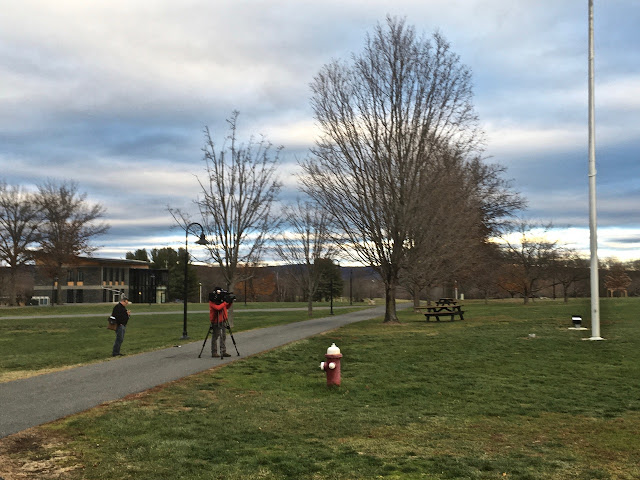By now practically everyone in the country has heard the story, regardless of whether you read the New York Times or watch Fox News. It was with a mixture of fascination and horror that I watched the slow-motion political train wreck that was the Hampshire College flag controversy unfold over more than a month.
Another metaphor that we use for a self-inflicted, completely avoidable disaster is: own goal.
Take Down the Flag!
 |
| Hampshire student chalk protest: Take Down the Flag |
It was immediately clear to me it was an untenable policy: it simply could not last. I decided to watch what happened, for the historical record.
Day 3 (14 November)
For Day 4, the middle of the first week, I thought three shots were in order:
general, close-up and night-time
Day 5 (16 November)
Day 6 (17 November)
Day 7 (18 November)
This is the only "dialogue" or "conversation" about the flag that I personally witnessed. (Evidently, the promised process happened in a series of "focus groups," but the vast majority of us were not involved. I certainly heard nothing.)
Negative space
Well, that didn't take long. The only thing more peculiar than the decision to fly the flag at half-staff for an extended period was the policy that soon replaced it. After only a week, on 18 November, the College announced, “we will not fly the U.S. flag or any other flags at Hampshire for the time being.” This, we were told, was so that we could discuss the meaning of the flag without the disturbing presence of (wait for it . . . ): the flag.
19 November: naked and alone
Raise the Flag!
A few days later, the press descended on the College.
 |
| November 22: filming an absence |
When the outside world learned of the decision, the most common reaction was one of anger and incomprehension. The only surprising thing was that the College, with all its intellectual wattage, was, well . . . surprised. Any ordinary person would have seen this coming.
Amherst’s Veterans of Foreign Wars Post 754 organized a mass protest on the Hampshire College campus on 27 November, the Sunday after Thanksgiving. People from around New England--particularly but not exclusively veterans--gathered at the entrance to the College on Route 116. The organizers estimated attendance at over 1,500 to 2,000: which is to say, greater than the typical annual enrollment at the College.
The event was nonpartisan in intention (and largely in practice) and the speakers included several left-liberal Democrats. I attended the rally to observe for myself. Although some subsequent press reports described at least one confrontation involving aggressive or offensive behavior, what I saw was by and large respectful and disciplined. The organizers stressed the need for civility and made a point of thanking the College for allowing them to meet on campus property. They offered to provide microphone time to the President or any other administrators who might be present (none were).
Press coverage, both local and national, was heavy.
The College soon faced a torrent of abuse in the form of angry phone calls and emails, as well as far harsher talk on social media--much like what the Town itself has experienced in the wake of controversies over flying the 9-11 commemorative flags or other contentious debates.
November 29: I have no idea what these temporary fences near the flag were intended to accomplish.
Back to normal?
On 2 December, the the College suddenly announced that the flag was being returned to its customary position on the main campus flagpole. Crisis over, but no problems solved.
After I took my pictures, a woman passing by said, "a lot of people doing that today."
There is a well known political dictum: when you're explaining, you're losing. The College has created a dedicated web page to explain its recent flag policy to the public.
* * *
Coming attractions
- photos of the protest rally against the College
- a more detailed look at the controversy
















1 comment:
Impressions beat out facts, every time.
Post a Comment